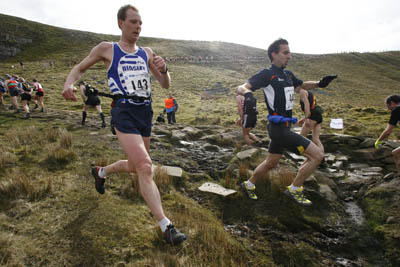 It is doubtful the quiet Yorkshire Dales village of Horton in Ribblesdale had ever seen anything like it.
It is doubtful the quiet Yorkshire Dales village of Horton in Ribblesdale had ever seen anything like it.
Andy Peace and Mitja Kosovelj race down Pen-y-ghent
Accustomed though it is to a regular weekend influx of visitors heading for the shapely fells surrounding it, the 498 inhabitants of the community found their home took on a distinctly more cosmopolitan feel as some of the globe’s top long-distance athletes – and their supporters, descended on Horton.
The World Long Distance Mountain Running Challenge – previous homes Sierre-Zinal, Switzerland , Manitou Springs, USA, Cauterets, France, and last year the Jungfrau, again in Switzerland – had come to Yorkshire, thanks to determined efforts by the organisers of the Three Peaks Race, an English institution in its 54th year.
American and antipodean accents competed with the Ribblesdale brogue, along with conversations in Russian, Norwegian, German, Czech and Spanish in the hostelries. Yet 810 home-grown runners had risen to the challenge from the best mountain runners in the world, determined not to be outdone as international mountain running met British fellrunning in one of the toughest tests on the calendar, the 24-mile slog over Pen-y-ghent, Whernside and Ingleborough.
Traffic choked the main street of Horton: not an occurrence you see every day; the village campsite was full and a helicopter hovered overhead taking TV footage.
The meteorologists had bolstered the chances of the British runners with forecasts of torrential rain and high winds, conditions not often encountered by Alpine runners. But the day dawned warm and dry on the late April Saturday, with hints of sunshine and the chance of dry racing conditions.
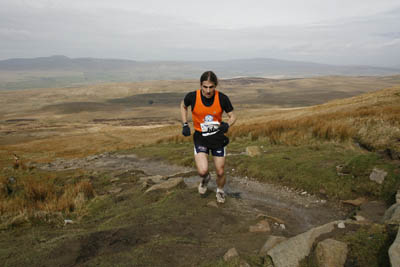 At 10am sharp, 754 runners set off from the village’s sports field on the route to the top of Pen-y-ghent. Early leader was the fancied US runner Zachary Freudenburg, who was strong on the steep climb to the lowest of the three peaks, at 694m (2,277ft).
At 10am sharp, 754 runners set off from the village’s sports field on the route to the top of Pen-y-ghent. Early leader was the fancied US runner Zachary Freudenburg, who was strong on the steep climb to the lowest of the three peaks, at 694m (2,277ft).
Zachary Freudenburg, in the lead on the ascent to Pen-y-ghent
Behind him snaked the following runners, already without last year’s women’s winner Mary Wilkinson who had pulled up. Freudenburg’s challenge would fade too, and by the time the leaders reached Ribblehead, across the mosses and bogs of the dale, Martin Cox, representing France, was heading the race, with Slovenian Mitja Kosovelj just a second behind.
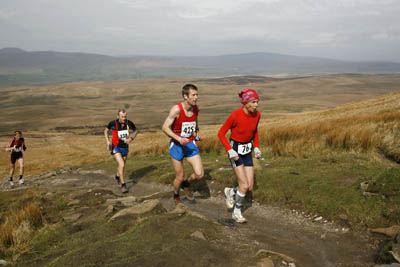 Fellrunning in Britain was proving a very different prospect for some of the mountain runners. Often, European mountain races are uphill only, ending on the summit, and the swift descent of rocky, slippery fell paths and tracks demands surefootedness and concentration.
Fellrunning in Britain was proving a very different prospect for some of the mountain runners. Often, European mountain races are uphill only, ending on the summit, and the swift descent of rocky, slippery fell paths and tracks demands surefootedness and concentration.
Despite its competitiveness, fellrunning is a tight-knit sport and it is common for the slower runners to shout encouragement to the fast descenders between breaths as they slog towards the summit yet to be gained. Exclamations of ‘Go on Jebby’ greeted last year’s winner Rob Jebb as he thundered down the slopes of Pen-y-ghent.
Neither mountain running nor fellrunning are dominated by young athletes. Stamina often comes with the years, and many top runners in the field are in early middle age. More than 300 of the male entrants in the Three Peaks were over 40, and a further 43 over the age of 60. Women too improve with age in the world of hill running, with only three participants under 25 and nearly 60 over the magic 40 mark.
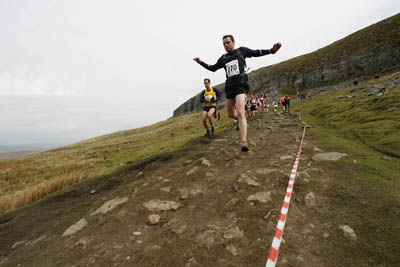 At Ribblehead, favourite viewing point for supporters, under the famous railway viaduct, 42-year-old Bingley Harrier Ian Holmes was in third place, just seven seconds behind the leader, despite recently suffering from a virus infection.
At Ribblehead, favourite viewing point for supporters, under the famous railway viaduct, 42-year-old Bingley Harrier Ian Holmes was in third place, just seven seconds behind the leader, despite recently suffering from a virus infection.
Twenty runners had dropped out by this time.
The route to the top of Whernside, the highest of the Three Peaks, takes a direct line, unlike the normal walking route, and is steep and relentless. By the summit checkpoint, Holmes had dropped back to 13th place – he later told grough he had set off at too fast a pace – and the Slovenian Kosovelj was now at the head of the increasingly strung out line of runners. Significantly, a young Glasgow athlete, Jethro Lennox, punched his tally at the summit just 30 seconds behind the Slovenian.
The sun had now disappeared and threatening clouds were massing in the West. An odd spot or two of rain peppered the summits but the promised downpour never materialised.
Andy Peace, the course record holder and another Bingley Harrier, performed strongly on the climb up to Whernside’s 736m (2,415ft) top, and put himself into fourth place, a minute and a half behind the race leader.
Norwegian Jon Tvedt, who had been tipped by many to figure strongly in the results, could only manage eighth place at this point; Czech Anna Pichrtova was the fastest woman, in 48th place. She later told grough how wonderful the view was from the top of the fell – obviously on peak form if she was able to admire the Dales scenery.
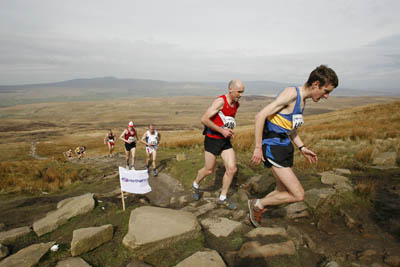 The descent of Whernside needs a lot of bottle: it’s steep, rocky and murderous on the knees. It was on the 436m (1,430ft) drop to the Hill Inn that 26-year-old Tom Owens, a Glasgow training chum of Lennox, but running for the Mercia club, made up seven places to join the leading trio. Pichrtova still led the women, having passed a further 12 of her male competitors, but Carnethy member Angela Mudge was starting to challenge her, 3½ minutes back.
The descent of Whernside needs a lot of bottle: it’s steep, rocky and murderous on the knees. It was on the 436m (1,430ft) drop to the Hill Inn that 26-year-old Tom Owens, a Glasgow training chum of Lennox, but running for the Mercia club, made up seven places to join the leading trio. Pichrtova still led the women, having passed a further 12 of her male competitors, but Carnethy member Angela Mudge was starting to challenge her, 3½ minutes back.
Jethro Lennox (right): first victory on the first attempt
Lennox said that he felt that the group he was in would contain the eventual winner and mentally he was worried he was going to ‘die’ ie, his strength would give up. The crowd of spectators and supporters gives a psychological boost to the runners before the last, big push up Ingleborough, a more gradual ascent with a steep sting in its tail, right at the very top, to gain the wide summit plateau.
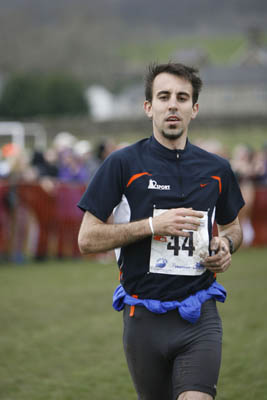 Lennox overtook the Slovenian on the flagged path leading up the flank to Humphrey Bottom. He would not be passed before the finish. His main concern, he said, was not Kosovelj but Owens. The pair trained regularly together in Glasgow and Lennox knew the Mercia man’s strengths.
Lennox overtook the Slovenian on the flagged path leading up the flank to Humphrey Bottom. He would not be passed before the finish. His main concern, he said, was not Kosovelj but Owens. The pair trained regularly together in Glasgow and Lennox knew the Mercia man’s strengths.
After leaving the Ingleborough checkpoint, the route doubles back on itself for 400m before heading east toward the slippery limestone of Sulber. The order of the top four off the final fell top was: Lennox, Kosovelj, Owens, Jebb.
All but 17m of the total climb of 1,608m (5,275ft) were behind the athletes now, but races have been lost and won on the final 7km (4½ miles). Lennox was to admit he found the last quarter of an hour of the race very difficult, but he held on to the lead and jubilantly crossed the finishing line in 2hr 53mins 39s. That’s an average speed of 12.95km per hour (8.05mph) for the 37.43km (23.26 mile) course.
So the local boys were beaten. Jebb, three times winner and a champion of the Three Peaks Cyclo-Cross Race, was more than five minutes behind the Glaswegian. Twenty minutes later, Sarah Rowell’s record was smashed by a minute and a half when the ebullient Czech Anna Pichrtova crossed the line.
“I was so happy just to be part of this. I just always try to do my best. The competition was so strong. All the girls are my friends, so whoever is the best on the day wins,” she said. It’s an attitude that is obvious to anyone standing on the finishing line. There’s a great camaraderie among the runners and all our interviews were punctuated with whoops of encouragement for fellow racers crossing the line.”
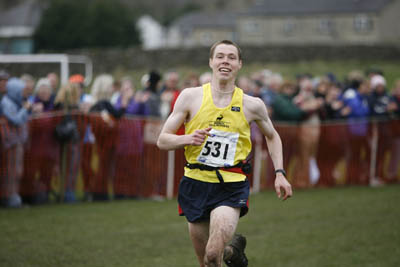 Second across the finish line was Tom Owens, grinning from ear to ear with delight at his performance. Taken under Jethro’s wing since moving to Glasgow from Birmingham, he was ecstatic having finished where he did. He said: “It’s not every day you beat those lads; there are some classy runners – the best of Britain and some of the world’s top runners.
Second across the finish line was Tom Owens, grinning from ear to ear with delight at his performance. Taken under Jethro’s wing since moving to Glasgow from Birmingham, he was ecstatic having finished where he did. He said: “It’s not every day you beat those lads; there are some classy runners – the best of Britain and some of the world’s top runners.
Tom Owens crosses the finish line
“This is probably one of the best known international fell races. It draws the best runners, and rightly so; it’s a long, hard fell race.
“The last two climbs hit you. There’s a long gap between them and it’s tough; I respect it a lot.”
Angela Mudge’s challenge to the Czech faded towards the end, and she was six minutes behind the Trenčín-born woman.
Pichrtova was one of many sporting the results of a tumble, a streak of blood down her muddy shin bone, the result of a fall, she said, due to choosing the wrong running shoes and sliding on the mud. But she dismissed the wound: ‘It’s nothing – very minor’.
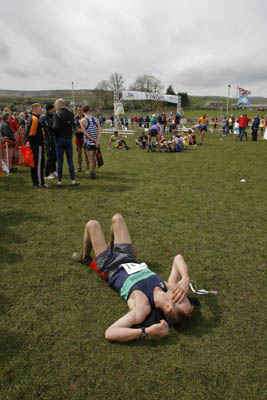 The ambulance staff in the first-aid tent were kept busy, with a plethora of minor injuries, chiefly leg gashes, cut hands, muscle strains and a few looking on the verge of hypothermia, though exhaustion was probably the real problem.
The ambulance staff in the first-aid tent were kept busy, with a plethora of minor injuries, chiefly leg gashes, cut hands, muscle strains and a few looking on the verge of hypothermia, though exhaustion was probably the real problem.
Out on the fells, the Clapham-based Cave Rescue Organisation – which despite its name is also a mountain rescue team – went to the aid of several runners. The team also had the loan of a garish yellow Hummer but it is likely that the trustworthy Land Rovers will remain the basis of the volunteers’ transport.
We spoke to race director, Paul Dennison, nervously surveying a hobbling runner crossing the finishing line. The event had been a great success, surely?
“It’s only a great success when the last person crosses the line,” he said. “We’ve had one or two casualties but the Yorkshire Ambulance staff and the St John Ambulance and the doctors have coped with that very well.
“There are one or two walking wounded. The CRO has been involved in helping out. They escorted a girl off Whernside. The ambulance service has brought one or two in.”
Apart from the emergency staff, there was a small army of volunteers helping to make the Three Peaks a success.
“There are over 120 marshals out on the course,” Dennison told grough. There were a further 30 marshals in and around the race-control area. “We’ve over 30 Raynet [radio] operators; three doctors, six St John Ambulance members, and eight Ambulance personnel, so there are an awful lot of people involved.
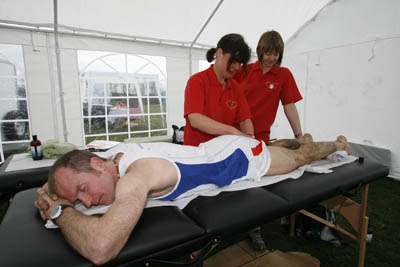 “It’s been good; a lot of apprehension early doors, but it’s all gone smoothly so far.”
“It’s been good; a lot of apprehension early doors, but it’s all gone smoothly so far.”
The event also boosted Horton, even if it did have to put up with a little traffic jam. There were 21 countries represented.
But more than anything, the Three Peaks Race felt like a good event to be part of. The top men and women may be the ones that grab the attention, but while they were recovering on the playing field at Horton, there were still hundreds of running shoes pounding the limestone and mud of the Pennine fells.
And it was those 685 runners, and the ones who fell by the wayside, who made the 2008 Three Peaks Race as big a success as it was.
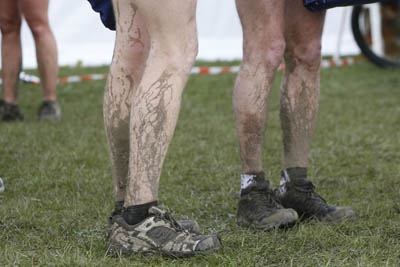 The blisters and the aches and the scars will fade, but the competitors of the 5th World Long-Distance Mountain Running Challenge will have sweet memories and some tall tales to tell their grandchildren.
The blisters and the aches and the scars will fade, but the competitors of the 5th World Long-Distance Mountain Running Challenge will have sweet memories and some tall tales to tell their grandchildren.
24 miles on: legs bear the marks of the Three Peaks
See more pictures from the 2008 Three Peaks Race and order prints from our photo site
See also
Hat trick for Three Peaks winner Rob Jebb
Mike Davies
29 April 2008The hardest thing I have ever done but a fantastic event so brilliantly organised, well done. We have nothing like this type of terrain in Winchester or in the south so me and my three running buddies who also took part were delighted to finish the course and really appreciate being given a place each. Thanks to all organisers, marshalls and everyone else involved.